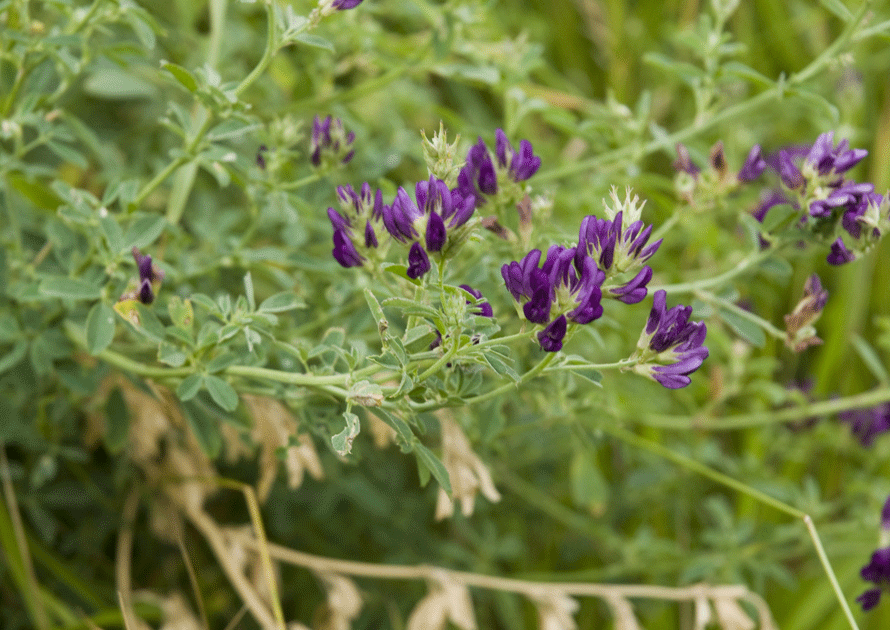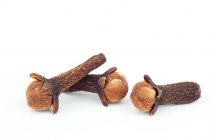 Alfalfa (Medicago sativa) is a perennial herb typically found rimming fields in low-lying valleys. It consists of a smooth stem that grows from an elongated taproot and reaches a height of a foot or more. Blue to purple flowers appear during the summer months, eventually producing spirally coiled seed pods.
Alfalfa (Medicago sativa) is a perennial herb typically found rimming fields in low-lying valleys. It consists of a smooth stem that grows from an elongated taproot and reaches a height of a foot or more. Blue to purple flowers appear during the summer months, eventually producing spirally coiled seed pods.
The ancient Persians fed their horses alfalfa to make them look sleeker and feel stronger. The Arabs designated it “the father of all food,” employing it as livestock feed. It continues to be widely used in this capacity by modern farmers due to its high nutritional value. The herb includes vitamins A, B-1, B-6, B-12, C, E, K-1, niacin, biotin, folic acid, pantothenic acid, and others. It also contains many amino acids, proteins, naturally occurring sugars (e.g., sucrose, fructose), major minerals, and trace elements such as iron, calcium, magnesium, potassium, phosphorus, zinc, and copper.
Because of their exceptional nutritional value, alfalfa sprouts make an excellent lettuce substitute. According to the August 1984 issue of the Journal of Nutrition (cited by Heinerman, 1996, p. 9), scientists at the University of California at Davis determined that the high manganese content in alfalfa extracts improved the condition of diabetics who failed to respond to insulin.
The herb has many other medicinal applications as well. Clinical nutritionists have demonstrated that alfalfa meal, when eaten by lab monkeys whose diets included considerable amounts of cholesterol, helped prevent atherosclerosis in addition to reducing serum cholesterol levels. Dr. Henry G. Bieler included the following story in his best-selling book, Food Is Your Best Medicine, to illustrate alfalfa’s value as an infection fighter. Coming upon a farmer in rural Idaho who was suffering from a very bad leg ulcer (to the point that the entire limb seemed close to becoming gangrenous), Bieler recommended
10 HERBAL MEDICINE AND BOTANICAL MEDICAL FADS
a blend of chopped alfalfa shoots and equal parts water and canned grapefruit juice. The leg condition eventually healed completely. The plant’s rich chlorophyll content has been used by doctors in some major hospitals since the 1940s to treat infections arising from surgical incisions, bedsores, and inner ear conditions. In these situations, patients drank fresh juice made by running raw alfalfa sprouts through a blender. Applying the juice externally to surface infections has also proven effective.
A Mormon farmer has recounted the following application of the herb in his autobiography, History of a Pioneer: Edward Leo Lyman, Jr. (1881-1958):
… [my father]said to me, “If you ever get the blues a sure cure is to go out and look at your alfalfa a while.” I’ve recommended this bit of sage advice to several farmers who faced foreclosures and were in deep depressions. A couple of them followed it and claimed afterwards just how therapeutic it was to gaze out on their fields of uncut alfalfa hay for an hour or so.
Bieler, Henry G. Food Is Your Best Medicine. New York: Vintage Books, 1973. Heinerman, John. “Alfalfa (Medicago sativa).” In: Heinerman’s Encyclopedia of Healing Herbs & Spices. Paramus, NJ: Prentice-Hall, 1996, pp. 7-10.
Lyman, Melvin A. History of a Pioneer: Edward Leo Lyman, Jr. (1881-1958).
Delta, UT: M.A. Lyman, 1959.



